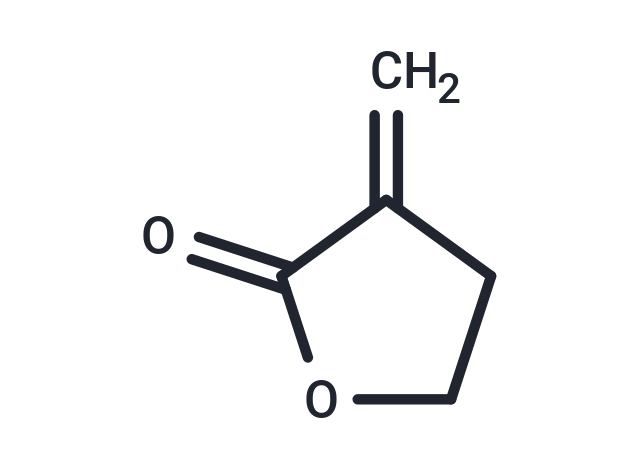Shopping Cart
Remove All Your shopping cart is currently empty
Your shopping cart is currently empty
Tulipalin A (α-methylene-γ-butyrolactone) (2-Methylenebutyrolactone) which has some phytotoxicity is a natural compound extracted from Tulipa gesneriana.

| Pack Size | Price | USA Warehouse | Global Warehouse | Quantity |
|---|---|---|---|---|
| 1 g | $38 | - | In Stock | |
| 5 g | $83 | - | In Stock | |
| 1 mL x 10 mM (in DMSO) | $29 | In Stock | In Stock |
| Description | Tulipalin A (α-methylene-γ-butyrolactone) (2-Methylenebutyrolactone) which has some phytotoxicity is a natural compound extracted from Tulipa gesneriana. |
| In vitro | Tulipalin A-induced phytotoxicity is persistent allergic contact dermatitis documented in floral workers exposed to Alstroemeria and its cultivars [1]. THP-1 cells showed strong robustness to Tulipalin A treatment since only five proteins were altered. In contrast, in Jurkat T cells an increase in the abundance of 66 proteins and a decrease of six proteins was determined [2]. |
| Cell Research | The influence of TUPA on cell viability was measured using the MTT assay. Cells were seeded in flat bottom 96-well plates at a density of 4 x 10^5 cells/ml. Afterward, Jurkat cells were exposed to TUPA in concentrations ranging from 10 to 82 μM. THP-1 cells (4 x 10^5 cells / ml) were exposed to concentrations ranging from 20 to 163 μM. After incubation for 72 h under humidified conditions (5 % CO2, 37 °C), 10 μl of MTT (5 mg/ml) per well were added and cells were further incubated for 3 h. Subsequently, 200 μl DMSO was added for cell lysis and formazan solubilization following incubation of the plates for 15 min while shaking. Afterward, absorbance was recorded at 550 nm and 620 nm using a microplate reader. In each plate, cells remained either untreated (negative control) or were exposed to Etoposide (2.5 μM) as a positive control. Using linear regression of the cell viability as a function of the compound concentrations, the concentrations leading to viability decreases of 10 % and 50 %, respectively, were calculated [2]. |
| Synonyms | α-methylene-γ-butyrolactone, 2-Methylenebutyrolactone |
| Molecular Weight | 98.1 |
| Formula | C5H6O2 |
| Cas No. | 547-65-9 |
| Smiles | C=C1CCOC1=O |
| Relative Density. | 1.119?g/mL?at 25?°C(lit.) |
| Storage | Pure form: -20°C for 3 years | In solvent: -80°C for 1 year | Shipping with blue ice/Shipping at ambient temperature. | |||||||||||||||||||||||||||||||||||
| Solubility Information | DMSO: 45 mg/mL (458.72 mM), Sonication is recommended. | |||||||||||||||||||||||||||||||||||
Solution Preparation Table | ||||||||||||||||||||||||||||||||||||
DMSO
| ||||||||||||||||||||||||||||||||||||
| Size | Quantity | Unit Price | Amount | Operation |
|---|

Copyright © 2015-2025 TargetMol Chemicals Inc. All Rights Reserved.